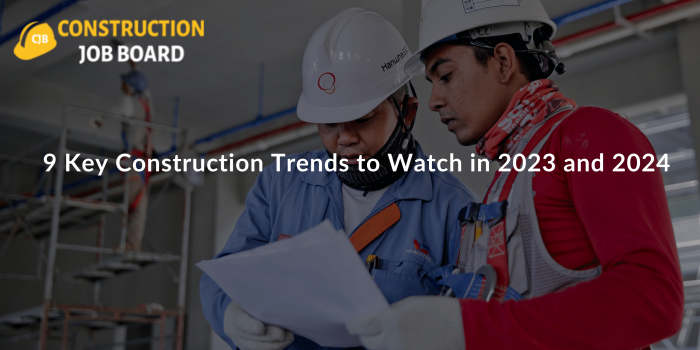Top 8 Construction Industry Trends To Watch For In 2023
Dec 18, 2022

2023 will be a year of re-emergence and expansion in the construction industry, following a volatile era of revising predictions and altering expectations. The 20s present several obstacles, ranging from the new normal of COVID-19 to the material shortages suffered by many contractors. Technology constantly changes the building site, increasing the capacity to win projects and profit margins. Harnessing these trends will benefit construction firms as the sector grows more competitive and the market transforms. Here are the 8 key trends of the construction industry for 2023.
Green Buildings
Green construction is the expected standard for homebuyers, renters, and business tenants. Renewable energy sources accounted for 11% of the energy market in 2019 (according to the US Energy Information Administration), and their share is only anticipated to grow as access improves. This is a massive industry because buildings still account for 40% of US energy and 30% of greenhouse gas emissions. Green construction incorporates technologies to reduce a building's carbon footprint and resource use and building models to reduce resource use.
Greenscaping, the practice of outfitting rooftops with plant coverings and tiny parks, is now popular in cities worldwide, as evidenced by Google's new multitiered London headquarters. This allows extensive greenscapes to cover the structure while increasing its resistance to high-powered storms caused by climate change.
Use of Digital Technologies
With labour shortages and declining profitability, construction technology promises better productivity, efficiency, and safety. Most construction companies are utilising digital technologies to develop business prospects and increase revenues by lowering long-term costs and improving project execution. Furthermore, the need for digital transformation in construction has grown significantly with rising global supply chain disruptions, competition, labour shortages, and skyrocketing material prices. These high-tech devices have also changed the construction business.
However, interested organisations must research which robots are best suited for aiding time-consuming or labour-intensive operations. Technology has affected every business, so it's no wonder the construction industry is following suit.
Advanced Building Materials
As researchers continue to produce new and more advanced components, the future of building materials appears bright. One emerging trend is using sophisticated building materials that are more effective and endure longer than traditional materials. These materials are also becoming more inexpensive, making them a more appealing option for building projects. Graphene is one example of an advanced building material.
Graphene is a thin, transparent carbon substance stronger than steel and has a variety of other desirable qualities. It can produce lightweight and long-lasting building coatings, which can help protect them from weather damage and other wear and tear. Graphene is also a good thermal conductor, which can be utilised to increase building energy efficiency. A calcium silicate board is another interesting, innovative building material. This material is resistant to fire, dampness, and pests and is manufactured from natural resources such as sand, clay, and lime. It is also non-toxic and safe for the environment.
High Demand for Labour
A shortage of personnel is not a new key trend in the construction sector. Quality labour is expensive and competitive, but robots can pick up much slack. Despite the best efforts of these robots, we will require more trained employees to handle and evaluate the data generated by new technology. While the need for construction services has increased in recent years, so has the number of labourers. Customer happiness becomes difficult without the labourers to fulfil deadlines and perform perfect finishing touches. Crews must have the appropriate labourers for seamless execution if organisations want repeat clients.
Fortunately, women are filling increasingly competitive roles. In construction recruiting efforts, the sector also targets Generation Z, born between 1995 and 2010.
Construction Management Software
Comprehensive construction management software is essential for maintaining competitiveness, growing a profitable business, and improving operational efficiency. While the capabilities and offerings of each software programme vary slightly, the top ones address end-to-end demands such as RFIs, data compilation, file sharing with mobile teams, budgeting, document storage, payroll and HR, and inventory management. Autodesk, Procore, Buildertrend, RedTeam, Fieldwire, and Quickbase are the top evaluated construction management software solutions for 2022.
Choosing the best construction management software for your company is critical. Begin with usability and integration with existing software. Look for expandable software to assist you in handling your needs now and in the future. Examine customisation choices, upgrades, extra features, and the availability of support and training.
Remote Worksites
Throughout 2020, construction organisations navigated tight safety measures while retaining productivity. Construction apps for mobile devices have grown the sector while keeping employees, clients, and contractors safe. As 2023 approaches, construction firms recognise the value of distant work sites and mobile access to their bottom line. Many construction steps can be handled remotely, saving time and money for both the contractor and the client. More technical breakthroughs for offshore work are planned, allowing projects to be completed faster than ever.
Monitoring with Drones
Drones offer a unique perspective that can aid with many activities, such as site surveys, mapping and even safety inspections. They are increasingly being utilised for construction monitoring since they can help cut expenses. Drones, for example, can survey a construction site before work begins, allowing the site to be mapped out and planning to start. This can save time and money because it eliminates the need to send someone to examine the place physically. Drones can also be used to track project development; by having a live view of the construction site, developers and contractors can discover possible problems early and remedy them before they become more serious problems.
Another advantage is that it allows you to chronicle the progress of a project so that you have a record of how it was constructed. Drones can be used to conduct building site safety inspections. Drone construction monitoring is still in its early phases but has enormous potential. We expect increased drone use on construction sites as technology advances.
Smart Cities
Some of the world's largest technology corporations, including IBM, Microsoft, and Cisco, invest extensively in megaprojects to develop smart, sustainable cities. The worldwide smart city market is predicted to expand by 20.5% by 2025, reaching $2.5 trillion. Masdar City in the United Arab Emirates, Songdo International Business District in South Korea, Hudson Yards in New York City, and India's Delhi-Mumbai Industrial Corridor are among the most noteworthy worldwide megaprojects. These projects range in cost from tens of billions to over $100 billion and are predicted to influence the economy, improve the infrastructure and contribute to the environment's health.
These construction industry trends are fast transforming the worldwide market; growing pricing and skilled labour shortages are expected to persist in the following decade. Regulatory obstacles may grow more stringent with an increased focus on workplace safety and climate change adaptation. Builders and developers can reduce risk, win more contracts, and profit by using new processes, utilising new technologies, and investing in new projects.
Conclusion
The construction sector is under pressure to become more efficient and incorporate new technology to improve information flow and construction processes. The overarching elements that connect these movements are environmental sustainability and software adoption. Surprisingly, these themes frequently result in cost reductions. Adopting new technology will be an important trend in the construction industry as companies aim to become more efficient and communicate more effectively. Construction companies that embrace the industry's shifting landscape will have greater chances, emphasising repairing infrastructure, sustainable buildings, and smart cities. Visit the Construction Job Board for more information on the construction industry.

























